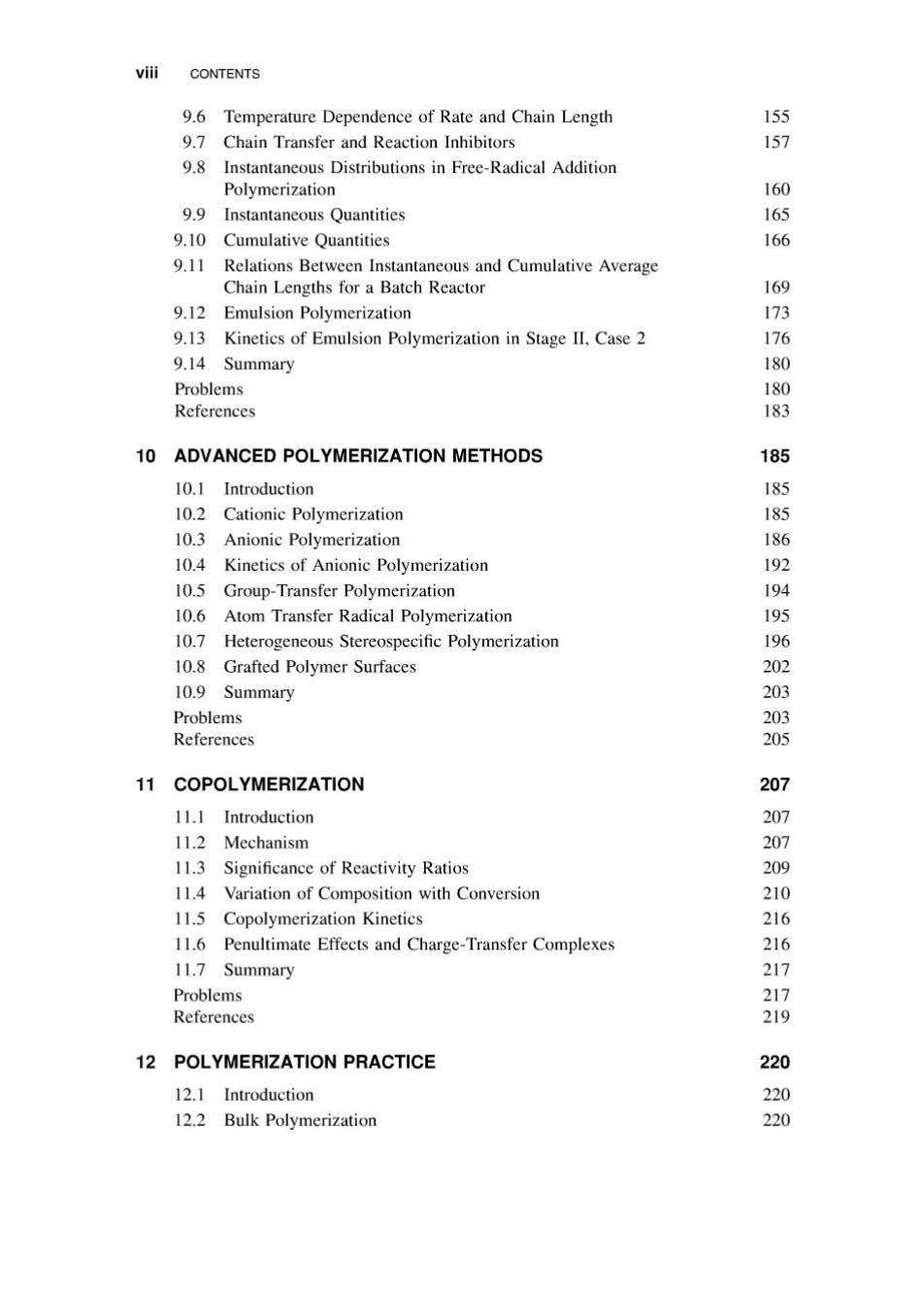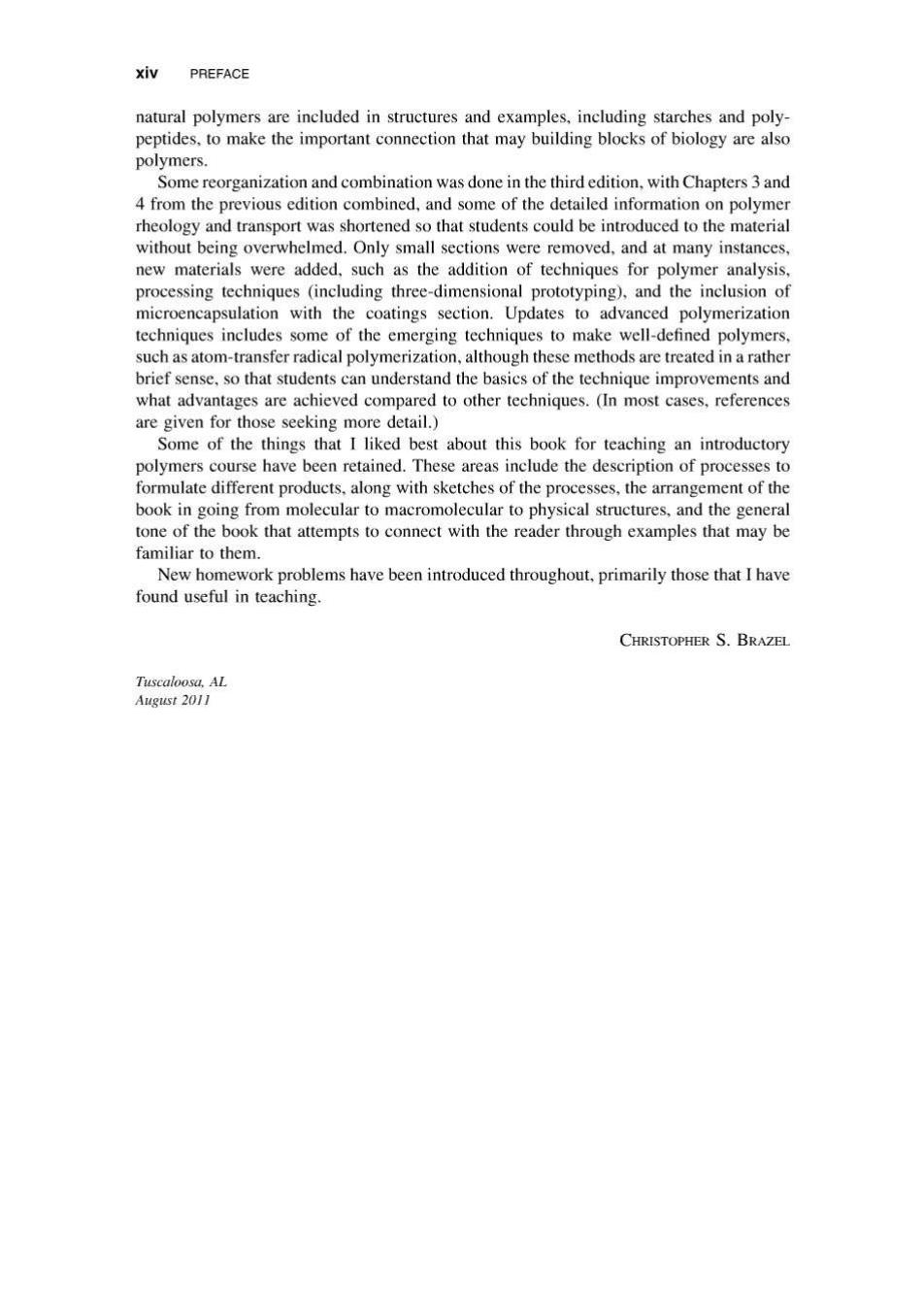
Third Edition FUNDAMENTAL PRINCIPLES OF POLYMERIC MATERIALS CHRISTOPHER S.BRAZEL STEPHEN L.ROSEN Linear Branched Crosslinked ③WILEY

CONTENTS PREFACE xiii PREFACE TO THE SECOND EDITION XV ACKNOWLEDGMENTS xvii 1 INTRODUCTION 1 Problems 7 References 7 PART I.POLYMER FUNDAMENTALS 9 2 TYPES OF POLYMERS 11 2.1 Reaction to Temperature 11 2.2 Chemistry of Synthesis 12 2.3 Structure 19 2.4 Conclusions 30 Problems 30 Reference 34 3 MOLECULAR STRUCTURE OF POLYMERS 35 3.1 Types of Bonds 35 3.2 Bond Distances and Strengths 35 3.3 Bonding and Response to Temperature 37 3.4 Action of Solvents 38

vi CONTENTS 3.5 Bonding and Molecular Structure 39 3.6 Stereoisomerism in Vinyl Polymers 40 3.7 Stereoisomerism in Diene Polymers 42 3.8 Summary 44 Problems 44 References 45 4 POLYMER MORPHOLOGY 46 4.1 Amorphous and Crystalline Polymers 47 4.2 The Effect of Polymer Structure,Temperature,and Solvent on Crystallinity 48 4.3 The Effect of Crystallinity on Polymer Density 49 4.4 The Effect of Crystallinity on Mechanical Properties 50 4.5 The Effect of Crystallinity on Optical Properties 51 4.6 Models for the Crystalline Structure of Polymers 53 4.7 Extended Chain Crystals 56 4.8 Liquid Crystal Polymers 57 Problems 59 References 60 5 CHARACTERIZATION OF MOLECULAR WEIGHT 61 5.1 Introduction 61 5.2 Average Molecular Weights 62 5.3 Determination of Average Molecular Weights 66 5.4 Molecular Weight Distributions 75 5.5 Gel Permeation (or Size-Exclusion)Chromatography (GPC,SEC) 79 5.6 Summary 85 Problems 86 References 89 6 THERMAL TRANSITIONS IN POLYMERS 91 6.1 Introduction 91 6.2 The Glass Transition 91 6.3 Molecular Motions in an Amorphous Polymer 92 6.4 Determination of Te 92 6.5 Factors that Influence T 95 6.6 The Effect of Copolymerization on T 97 6.7 The Thermodynamics of Melting 97 6.8 The Metastable Amorphous State 100 6.9 The Influence of Copolymerization on Thermal Properties 101 6.10 Effect of Additives on Thermal Properties 102

CONTENTS vii 6.11 General Observations about Te and Tm 103 6.12 Effects of Crosslinking 103 6.13 Thermal Degradation of Polymers 103 6.14 Other Thermal Transitions 104 Problems 104 References 106 7 POLYMER SOLUBILITY AND SOLUTIONS 107 7.1 Introduction 107 7.2 General Rules for Polymer Solubility 107 7.3 Typical Phase Behavior in Polymer-Solvent Systems 109 7.4 The Thermodynamic Basis of Polymer Solubility 110 7.5 The Solubility Parameter 112 7.6 Hansen's Three-Dimensional Solubility Parameter 114 7.7 The Flory-Huggins Theory 116 7.8 Properties of Dilute Solutions 118 7.9 Polymer-Polmyer-Common Solvent Systems 121 7.10 Polymer Solutions,Suspensions,and Emulsions 121 7.11 Concentrated Solutions:Plasticizers 122 Problems 124 References 126 PART II.POLYMER SYNTHESIS 129 8 STEP-GROWTH(CONDENSATION)POLYMERIZATION 131 8.1 Introduction 131 8.2 Statistics of Linear Step-Growth Polymerization 132 8.3 Number-Average Chain Lengths 133 8.4 Chain Lengths on a Weight Basis 136 8.5 Gel Formation 137 8.6 Kinetics of Polycondensation 142 Problems 143 References 145 9 FREE-RADICAL ADDITION(CHAIN-GROWTH) POLYMERIZATION 146 9.1 Introduction 146 9.2 Mechanism of Polymerization 147 9.3 Gelation in Addition Polymerization 148 9.4 Kinetics of Homogeneous Polymerization 149 9.5 Instantaneous Average Chain Lengths 153

viii CONTENTS 9.6 Temperature Dependence of Rate and Chain Length 155 9.7 Chain Transfer and Reaction Inhibitors 157 9.8 Instantaneous Distributions in Free-Radical Addition Polymerization 160 9.9 Instantaneous Quantities 165 9.10 Cumulative Quantities 166 9.11 Relations Between Instantaneous and Cumulative Average Chain Lengths for a Batch Reactor 169 9.12 Emulsion Polymerization 173 9.13 Kinetics of Emulsion Polymerization in Stage II,Case 2 176 9.14 Summary 180 Problems 180 References 183 10 ADVANCED POLYMERIZATION METHODS 185 10.1 Introduction 185 10.2 Cationic Polymerization 185 10.3 Anionic Polymerization 186 10.4 Kinetics of Anionic Polymerization 192 10.5 Group-Transfer Polymerization 194 10.6 Atom Transfer Radical Polymerization 195 10.7 Heterogeneous Stereospecific Polymerization 196 10.8 Grafted Polymer Surfaces 202 10.9 Summary 203 Problems 203 References 205 11 COPOLYMERIZATION 207 11.1 Introduction 207 11.2 Mechanism 207 11.3 Significance of Reactivity Ratios 209 11.4 Variation of Composition with Conversion 210 11.5 Copolymerization Kinetics 216 11.6 Penultimate Effects and Charge-Transfer Complexes 216 11.7 Summary 217 Problems 217 References 219 12 POLYMERIZATION PRACTICE 220 12.1 Introduction 220 12.2 Bulk Polymerization 220

CONTENTS ix 12.3 Gas-Phase Olefin Polymerization 225 12.4 Solution Polymerization 226 12.5 Interfacial Polycondensation 228 12.6 Suspension Polymerization 229 12.7 Emulsion Polymerization 232 12.8 Summary 234 Problems 234 References 235 PART III.POLYMER PROPERTIES 237 13 RUBBER ELASTICITY 239 13.1 Introduction 239 13.2 Thermodynamics of Elasticity 239 13.3 Statistics of Ideal Rubber Elasticity 246 13.4 Summary 248 Problems 248 References 249 14 INTRODUCTION TO VISCOUS FLOW AND THE RHEOLOGICAL BEHAVIOR OF POLYMERS 250 14.1 Introduction 250 14.2 Basic Definitions 251 14.3 Relations Between Shear Force and Shear Rate:Flow Curves 252 14.4 Time-Dependent Flow Behavior 254 14.5 Polymer Melts and Solutions 255 14.6 Quantitative Representation of Flow Behavior 256 14.7 Temperature Dependence of Flow Properties 259 14.8 Influence of Molecular Weight on Flow Properties 262 14.9 The Effects of Pressure on Viscosity 263 14.10 Viscous Energy Dissipation 264 14.11 Poiseuille Flow 265 14.12 Turbulent Flow 268 14.13 Drag Reduction 269 14.14 Summary 271 Problems 271 References 274 15 LINEAR VISCOELASTICITY 276 15.1 Introduction 276 15.2 Mechanical Models for Linear Viscoelastic Response 276

CONTENTS 15.3 The Four-Parameter Model and Molecular Response 285 15.4 Viscous or Elastic Response?The Deborah Number 288 15.5 Quantitative Approaches to Model Viscoelasticity 289 15.6 The Boltzmann Superposition Principle 293 15.7 Dynamic Mechanical Testing 297 15.8 Summary 304 Problems 304 References 307 16 POLYMER MECHANICAL PROPERTIES 308 16.1 Introduction 308 16.2 Mechanical Properties of Polymers 308 16.3 Axial Tensiometers 309 16.4 Viscosity Measurement 311 16.5 Dynamic Mechanical Analysis:Techniques 316 16.6 Time-Temperature Superposition 323 16.7 Summary 329 Problems 329 References 332 PART IV.POLYMER PROCESSING AND PERFORMANCE 335 17 PROCESSING 337 17.1 Introduction 337 17.2 Molding 337 17.3 Extrusion 344 17.4 Blow Molding 347 17.5 Rotational,Fluidized-Bed,and Slush Molding 348 17.6 Calendering 349 17.7 Sheet Forming (Thermoforming) 350 17.8 Stamping 351 17.9 Solution Casting 351 17.10 Casting 351 17.11 Reinforced Thermoset Molding 352 17.12 Fiber Spinning 353 17.13 Compounding 355 17.14 Lithography 358 17.15 Three-Dimensional (Rapid)Prototyping 358 17.16 Summary 359 Problems 359 References 360

CONTENTS xi 18 POLYMER APPLICATIONS:PLASTICS AND PLASTIC ADDITIVES 361 18.1 Introduction 361 18.2 Plastics 361 18.3 Mechanical Properties of Plastics 362 18.4 Contents of Plastic Compounds 363 18.5 Sheet Molding Compound for Plastics 371 18.6 Plastics Recycling 373 Problems 374 References 374 19 POLYMER APPLICATIONS:RUBBERS AND THERMOPLASTIC ELASTOMERS 375 19.1 Introduction 375 19.2 Thermoplastic Elastomers 375 19.3 Contents of Rubber Compounds 376 19.4 Rubber Compounding 379 References 379 20 POLYMER APPLICATIONS:SYNTHETIC FIBERS 380 20.1 Synthetic Fibers 380 20.2 Fiber Processing 380 20.3 Fiber Dyeing 381 20.4 Other Fiber Additives and Treatments 381 20.5 Effects of Heat and Moisture on Polymer Fibers 381 21 POLYMER APPLICATIONS:SURFACE FINISHES AND COATINGS 383 21.1 Surface Finishes 383 21.2 Solventless Coatings 385 21.3 Electrodeposition 387 21.4 Microencapsulation 387 Problem 389 References 389 22 POLYMER APPLICATIONS:ADHESIVES 390 22.1 Adhesives 390 References 394 INDEX 395

PREFACE This work has been edited and organized to provide a solid understanding of the main concepts of polymeric materials at an introductory level,suitable for undergraduate and beginning graduate students in disciplines ranging from chemistry and chemical engineer- ing to materials science,polymer engineering,and mechanical engineering.The second edition of the textbook was organized in a way that flowed naturally from molecular-level considerations to bulk properties,mechanical behavior,and processing methods.I have kept that organization intact with this third edition.I have used this book in teaching a polymer materials engineering course over the past several years,and find that enough information is presented without overwhelming students in detail (i.e.,for more detailed courses beyond the introductory polymer class). One of the big challenges in updating a textbook is to include some of the newer materials,methods,and issues surrounding polymer science while editing and refining the original material so that the end product remains fairly streamlined and provides a balance between describing theories and methodologies while treating each subject with an appropriate weighting.(Of course,instructors are certainly invited to pick and choose topics for their classes,and add material to that covered in the text,but I hope that this provides a good.solid read for students learning the material for the first time without a significant need to supplement the book on the instructor's behalf and without providing so much information that significant portions of the book must be passed over in a one- semester course. The text should be suitable for advanced undergraduates and beginning graduate students in disciplines ranging from chemical engineering and chemistry to materials science and mechanical engineering.I have taught mixed classes with just this background using the second edition,and usually found that some introductory information(such as organic chemical structures)was needed-both for students who had not been formally trained in organic chemistry and for those who needed a refresher.This edition now includes a short section in Chapters 1 and 2 on organic functional groups,with an emphasis on some of the structures found in condensation polymerizations.Several instances of xiii

xiv PREFACE natural polymers are included in structures and examples,including starches and poly- peptides,to make the important connection that may building blocks of biology are also polymers. Some reorganization and combination was done in the third edition,with Chapters 3 and 4 from the previous edition combined,and some of the detailed information on polymer rheology and transport was shortened so that students could be introduced to the material without being overwhelmed.Only small sections were removed,and at many instances, new materials were added,such as the addition of techniques for polymer analysis, processing techniques (including three-dimensional prototyping),and the inclusion of microencapsulation with the coatings section.Updates to advanced polymerization techniques includes some of the emerging techniques to make well-defined polymers, such as atom-transfer radical polymerization,although these methods are treated in a rather brief sense,so that students can understand the basics of the technique improvements and what advantages are achieved compared to other techniques.(In most cases,references are given for those seeking more detail.) Some of the things that I liked best about this book for teaching an introductory polymers course have been retained.These areas include the description of processes to formulate different products,along with sketches of the processes,the arrangement of the book in going from molecular to macromolecular to physical structures,and the general tone of the book that attempts to connect with the reader through examples that may be familiar to them. New homework problems have been introduced throughout,primarily those that I have found useful in teaching. CHRISTOPHER S.BRAZEL Tuscaloosa.AL Aug1s12011